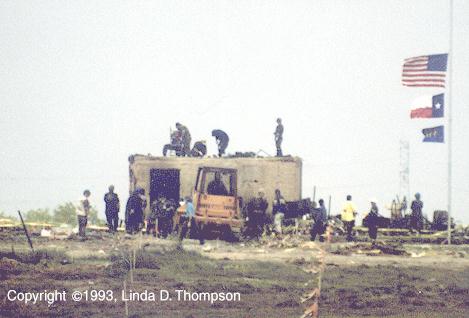
|
|
|
The "bunker" (so-called by the government and the media) was an old safe from some long gone building before the Davidians occupied the land. The Davidians incorporated the structure into the first floor of the Mt. Carmel Center, and here it is shown after the rest of the Center was destroyed by fire. The structure could not be used as a bunker: it had no firing positions, would provide no advantage in a firefight, and was completely enclosed in the wooden structure of the Center, which would block the sight of any approaching enemy; simply stated, it could never serve as a bunker. The Davidians used it for food and (apparently) ammunition storage. |
The Department of Justice Report, the Autopsy Reports of the Tarrent County Medical Examiner's Office, at least one Branch Davidian survivor, and the popular press say that many of the women and children died in the concrete room when it collapsed.

The Waco Tribune-Herald told the world that the "bunker" collapsed, killing some of the women and children inside (May 18, 1993, cached). That scenario echoed an earlier Tribune article published April 30, 1993 (cached).
Note: The chemical called "CS gas" (2-chlorobenzalmalononitrile) and its properties were introduced in the Introduction to the Fire Gallery.
The narratives of those deaths contain one or more of the following elements:
- The victims were alive on April 19;
- Sometime in the morning of April 19, the women and children sought refuge from the CS gas and/or the tanks in the concrete room;
- The mothers had gas masks, the children did not;
- The mothers brought buckets of water into the concrete room and pieces of cloth. In order to protect the children from the CS gas, they soaked the cloths in the water and put them over the faces of the children;
- Wet towels, blankets, and sleeping bags were used by the mothers and the children as a shield from the CS gas;
- The structure collapsed;
- As a result of the structural collapse, many died of blunt force trauma or were "buried alive" or suffocated;
- Others died of smoke inhalation;
- Others died of gunshot wounds;
- The gunshot wounds were inflicted on children by mothers who committed mercy killings, and then committed suicide in order to avoid the horrible death of burning alive;
- The ammunition caught fire in the concrete room, incinerating the bodies.
The above scenario is a composite drawn from the following sources: Dr. Nizam Peerwani and Dr. Rodney Crow of the Tarrant County medical examiner's office, the official Autopsy Reports written by that office, the Department of Justice Report, and the account of Branch Davidian David Thibodeau. Their stories will be examined as the Museum tour proceeds, to see if the evidence corroborates the account.
Secondary sources, such as newspapers, repeated the story of the "collapse" with exaggerated detail. For example, The Washington Post, July 20, 1995 (cached).
The Bunker. A concrete room near the complex's cafeteria. More than 40 Branch Davidians died inside or near the bunker on April 19, 1993, apparently while seeking a fireproof haven. Tons of concrete collapsed, burying, crushing and suffocating about 13 people. Investigators say vibrations from the dozen tanks on the scene or falling fire debris—or both—contributed to the bunker's collapse.
The story of the "collapsed bunker" is now a part of the common (and fake) knowledge of the Waco Holocaust.